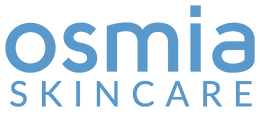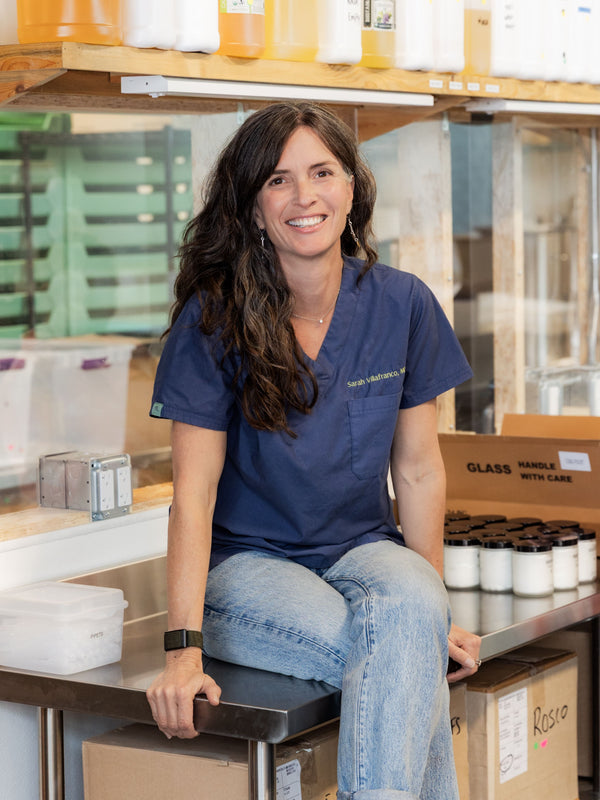Raise your hand if you or someone you love has battled eczema, dry patches, itchy skin, rashes, or some form of dermatitis in the past year. (We’re guessing your hand is up.) Sensitive skin issues are everywhere, and the numbers keep climbing.
So, what’s behind this growing wave of skin frustration? I have a theory—and it centers around a single ingredient that’s crept into nearly every part of our daily routine over the last 80 years—an ingredient that was never meant for human skin in the first place.
A Look Back: How We Used to Treat Our Skin
Long before the rise of synthetic ingredients and bottled beauty, humans relied on the healing properties of nature. The Egyptians and Greeks used honey, olive oil, yogurt, and clay to nourish and clarify the skin. These natural ingredients offered antibacterial action, gentle exfoliation, and a boost of essential minerals.
In Medieval times, the routines became a little more inventive—think aloe, cucumber, and vinegar toners. Still, mostly plant-powered and skin-supportive.
Then came the Renaissance, and things took a turn for the worse. Enter white lead masks and sulfur powders—efforts to lighten the skin at the expense of, well, your health. Those trends thankfully faded (along with the complexions and wellbeing of those who used them), but they marked the beginning of a long and winding path away from nature and toward synthetic “solutions.”
Over the last century, things have accelerated faster than ever—with one foaming chemical leading the charge.
The Ingredient at the Heart of the Problem
In the late 1800s and early 1900s, personal care companies introduced now-familiar staples like Vaseline, baby powder, sunscreen, and lip balm, some safer than others . But around the 1940s, something else entered the scene—something that would quietly, persistently alter the health of our skin for generations.
Sodium lauryl sulfate (SLS)—a powerful detergent—was allegedly first used as an engine degreaser during World War II. Eventually, someone decided that if it could degrease machinery, it could probably degrease your skin. Before long, SLS and its cousins (sodium laureth sulfate and sodium cocosulfate) were everywhere: shampoo, toothpaste, face wash, body wash, shaving cream, hand soap, mouthwash, laundry detergent, even bubble bath. Today, you’ll find these ingredients in countless products—even in loads of natural brands. (Note: sodium cocosulfate is a similar molecule, but slightly larger and therefore slightly better in terms of skin irritation. Sodium laureth sulfate is an ethoxylated version of SLS, said to be gentler on the skin, but it may be contaminated with 1,4-dioxane, so it’s not a great alternative.)
So what’s the issue? While SLS does create that satisfying lather and squeaky-clean feeling, it often comes at a cost: irritation, inflammation, and a compromised skin barrier. If you’ve ever had dry, red, tight, or flaky skin after washing, there’s a good chance SLS was involved.
Is Sodium Lauryl Sulfate Safe? Depends on Who You Ask.
A 1983 study published in the International Journal of Toxicology deemed SLS and ammonium lauryl sulfate “safe for discontinuous, brief use followed by thorough rinsing.” Am I the only one raising an eyebrow here? By that logic, motor oil, moose poop, or hot sauce might also be “safe” if you rinse them off right away—but that doesn’t mean they belong on your skin.
Here’s the more concerning part: SLS has been used in medical research for decades precisely because it causes irritation. In lab settings, it’s used to trigger inflammation deliberately for testing anti-inflammatory treatments. In fact, studies have shown that even low concentrations of SLS can impair moisture retention and damage the skin’s barrier function.
So why is it still so common? Because it’s cheap, it foams beautifully, and most people don’t know it’s the thing silently sabotaging their skin.
Who’s Sensitive to Sodium Lauryl Sulfate? (Spoiler: A Lot of Us)
If you’ve ever felt like your skin is sensitive to everything, you’re not imagining things. My (still unproven but strongly supported) theory is this: decades of daily exposure to SLS and its derivatives have left many of us in a state of chronic, low-level skin irritation. And when you strip the skin barrier repeatedly, it eventually stops bouncing back the way it used to.
Over time, this can lead to a higher likelihood of developing conditions like eczema, dermatitis, and other forms of skin reactivity. In some cases, prolonged exposure may even result in actual allergy to SLS—a hypersensitivity that turns into a cycle of flares, inflammation, and confusion when your skin keeps reacting but you can’t figure out why.
Think about how many times a day you use something that foams. Now consider how many of those products might contain SLS or a similar surfactant. It’s not just your face wash—it’s your shampoo, your toothpaste, your laundry detergent, your dish soap. That adds up fast.
When your skin is exposed to a harsh surfactant in multiple products, day after day, it can quietly erode the skin’s barrier function—the thing that protects you from moisture loss and environmental aggressors. The result? Skin that’s drier, more reactive, and slower to heal.
How to Get Rid of Sodium Lauryl Sulfate (SLS)
If your skin has been red, itchy, flaky, or unpredictable, removing SLS from your life is a great place to start. But doing it thoroughly means more than just switching to a different face wash. You’ll want to do a full sweep of every foaming product you use—on your body, in your home, and on your clothes.
Here’s what to check:
- Shampoo + Conditioner (especially ones that lather heavily)
- Body wash + Bubble bath
- Face cleanser
- Toothpaste
- Hand soap
- Shaving cream
- Laundry detergent
- Dish soap
Check the ingredient lists for these ingredients: sodium lauryl sulfate, sodium laureth sulfate, ammonium lauryl sulfate, or sodium coco sulfate. These are all surfactants that may strip the skin or disrupt the barrier. While sodium coco sulfate is slightly less irritating because of its larger molecular size, it can still be a trigger for sensitive skin.
Once you’ve done the full sweep, replace those products with gentler alternatives made without sulfates or synthetic fragrance (another sneaky source of irritation). If your skin is highly reactive, go fully fragrance-free for a few weeks and allow your barrier to recover. Then, you can try slowly reintroducing products with skin-safe essential oils—one at a time.
It might feel like a lot of label-reading up front, but your skin will thank you. And once you’ve made the switch, it’s easy to maintain. Think of it as a gentle reset for your largest organ.
Which Osmia Products Are Best for Sensitive Skin?
Sensitive skin doesn’t mean you have to settle for boring or bland. At Osmia, we formulate several products specifically for reactive skin, so you can nourish and pamper yourself without triggering inflammation, rashes, or dryness.
Here are our top picks:
Oh So Body Soap
Our best-selling bar for sensitive skin is as gentle as it gets. Made with organic olive oil, mango butter, and sea salt, it’s free of essential oils and ideal for skin that needs a break. Think of it as a castile-style cleanser, but creamier and more luxurious.
Oh So Detox Body Soap
Prefer a deeper cleanse? This bar uses shea butter and activated bamboo charcoal to detoxify without stripping your skin. Like the original, it contains no essential oils and is beloved by people with perioral dermatitis, eczema, or fragrance sensitivities.
Naked Body Soap
A slightly smaller bar, also without essential oils. This bar doubles beautifully as a shampoo bar, and works well for smaller hands, making it a great choice for kids with eczema or sensitive skin.
Naked Body Oil
Eleven botanical oils—zero essential oils. This silky blend sinks into wet skin and leaves it deeply nourished without a greasy finish. It’s the body oil we recommend most often for those in barrier repair mode.
Naked Body Mousse
Our ultra-whipped body butter, minus the scent. Use it solo or pair it with the Naked Body Oil for a richer, longer-lasting moisture boost. It’s a dream for dry elbows, knees, and winter skin in general.
Here’s the great news for sensitive skin: changing your routine doesn’t mean you have to deprive yourself of the good things in life. Our sensitive skin products are luxurious, effective, and delightful to use in your daily routines. In fact, you might find that once you go Naked, you never go back to anything else.
With love and WAY fewer rashes from us to you,

The information contained in this post is for educational interest only. This information is not intended to be used for diagnosis or treatment of any physical or mental illness, disease, or skin conditions.
Resources:
- Robinson VC, Bergfeld WF, Belsito DV, Hill RA, Klaassen CD, Marks JG Jr, Shank RC, Slaga TJ, Snyder PW, Alan Andersen F. Final report of the amended safety assessment of sodium laureth sulfate and related salts of sulfated ethoxylated alcohols. Int J Toxicol. 2010 Jul;29(4 Suppl):151S-61S. doi: 10.1177/1091581810373151. PMID: 20634505.
- Soltanipoor M, Stilla T, Riethmüller C, Thyssen JP, Sluiter JK, Rustemeyer T, Fischer TW, Kezic S, Angelova-Fischer I. Specific barrier response profiles after experimentally induced skin irritation in vivo. Contact Dermatitis. 2018 Aug;79(2):59-66. doi: 10.1111/cod.12981. Epub 2018 Apr 2. PMID: 29607504; PMCID: PMC6099430.























